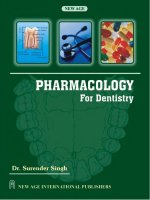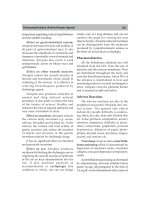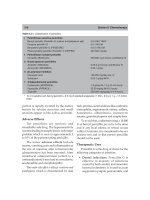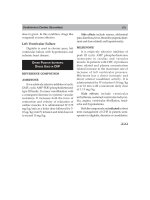Pharmacology for dentistry phần 37
Bạn đang xem bản rút gọn của tài liệu. Xem và tải ngay bản đầy đủ của tài liệu tại đây (65.58 KB, 5 trang )
This page
intentionally left
blank
r
r
e
e
t
t
p
p
a
CChh
4.1
1.4
Cardiotonics
Pharmacodynamics
(Cardiac
Glycosides)
(Mode of
Action of Drugs)
Congestive heart failure (CHF) is a clinical
syndrome with multiple causes and involve
the right or left ventricle or both and in CHF,
cardiac output is usually below the normal
range. This ventricular dysfunction may be
systolic, which leads to inadequate force
generation to eject blood normally and
diastolic, which leads to inadequate
relaxation to permit normal filling. Systolic
dysfunction, with decreased cardiac output
and significantly reduced ejection fraction
is typical of acute heart failure, especially
that resulting from myocardial infarction.
CARDIAC GLYCOSIDES
There are the drugs having cardiac inotropic
property. They increase myocardial
contractility and cardiac output in a
hypodynamic heart without increase in
oxygen consumption and overall
myocardial efficiency is increased.
The cardiac glycosides are mainly
obtained from plants e.g. digitalis,
stropanthus and squill species and also
present in certain other plants and animals.
In 1776, William Withering, a Birmingham
physician and botanist identified digitalis
and other ingredients, which was found
useful in the treatment of dropsy. In 1911,
Mackenzie and Cushney studied the effect
of digitalis on heart and its use in congestive
heart failure.
The important cardiac glycosides are
listed in table 4.1.1.
Pharmacological Actions
Effect on Heart
Contractility: Digitalis increases the force of
myocardial contraction without causing
corresponding increase in the oxygen
consumption. This pharmacological action
forms the basis of its use in treatment of
CHF. In a patient of CHF, force of
contraction of the heart at a given fibre
length is decreased, thus the stroke volume
is decreased. As digitalis increases the force
of contraction of the heart and subsequently,
it increases the cardiac output, increase in
circulating velocity, residual volume is
decreased, diastolic volume is decreased
and size of heart is decreased but these
effects are noticed secondary to increase in
170
Section 4/ Drugs Acting on Cardiovascular & Urinary System
Table 4.1.1: Classification of cardiac glycosides.
I
Natural glycosides
Digitoxin (DIGITALIN)
Digoxin (LANOXIN)
Lanatoside-C (CEDILANID)
Stropanthin-K (STROPHOSID)
Stropanthin-G (OVABAIN)
Proscillaridin-A
Cavallotoxin
Thevetin
Bufotoxin
II. Semisynthetic
Acetyl digoxin (ACYLANID)
Desacetyl lanatoside-C (DESLANOSIDE)
Acetyl stropanthidin (diagnostic use)
0.05-0.2 mg/day
0.125-0.5 mg/day oral
0.25-1.0 mg slow IV
0.25-1.0 mg/day
0.25-0.5 mg IV
0.25-0.5 mg IV
0.3-1.0 ml (Tr. Scilla)
0.2-0.5 mg/day oral/IV
0.25-1 mg IV
0.25 mg IV
contractility and are not the primary effects
of digitalis.
sympathetic tone and thus reducing the
heart rate.
Cardiac output: Digitalis increases the
cardiac output in CHF patients by increasing
the force of myocardial contraction. It also
increases the contractility of normal heart
but cardiac output remains unchanged or is
slightly decreased. In normal individuals, it
increases the tone of arteries as well as that
of the veins.
Refractory period: It is a period after onset
of depolarization during which a stimulus can
not evoke a propagated action potential. In
atrium, refractory period is shortened by vagal
action and increased by direct action.
Heart rate: In CHF patients, the heart
rate is decreased. Digitalis produce a
decrease in heart rate by stimulation of
vagus. The ‘vagal effect’ is probably evoked
by sensitization of carotid baroreceptors,
and by direct stimulation of vagal centre.
The vagal action can be blocked by atropine
but after full digitalising dose the effect can
not be blocked by atropine and it is due to
its direct cardiac action. In CHF patients,
the sympathetic activity is increased as a
compensatory phenomenon which leads to
tachycardia. Digitalis decreases the
SA node: Digitalis sensitizes the SA node
to normal vagal impulse resulting in
bradycardia. In a patient suffering from
paroxysmal supraventricular tachycardia, it
decreases the heart rate due to vagal action on
SA node which is associated with decrease in
the slope of slow diastolic depolarisation and
increase in the transmembrane negativity and,
also lower the SA rate by antiadrenergic action.
Automaticity: It is the ability to generate
propagated impulse. Digitalis increases the
ability of the Purkinje cell and the
ventricular muscle to initiate impulses.
Conductivity: Conduction through AV
node is depressed whereas conduction is
slightly increased in the auricle and ventricles.
Cardiotonics (Cardiac Glycosides)
171
ECG changes: Digitalis, in therapeutic
doses causes inversion of T wave, sagging
of S-T segment and shortening of Q-T
internal (shortening of systole). In toxic dose,
it causes prolongation of P-R interval
(slowing of AV conduction), atrial
arrhythmias (atrial tachycardia and atrial
fibrillation) with AV block and ventricular
arrhythmias.
may probably explain reversal of toxic effects
of digitalis by potassium. Inhibition of the Na+
K+-ATPase leads to increase in intracellular
sodium and decrease in potassium.
Extracardiac Actions
Digitalis also exerts some indirect action
on heart mainly by increase in vagal activity
which ultimately influences activity of AV
node, SA node and auricles.
• Digitalis produces diuresis in CHF
patients, it increases excretion of
sodium and water by the kidney
which may be due to decrease in the
venous pressure bringing about
shifting of edema fluid into the
circulation and also improves the
renal circulation.
• Digitalis can produce nausea and
vomiting which is probably due to the
chemoreceptor trigger zone (CTZ)
stimulation.
• Digitalis has mild vasoconstrictor action
increasing the peripheral resistance. But
in CHF patients peripheral resistance
decreases due to withdrawal of reflex
sympathetic overactivity. Venous tone
improves in normal as well as CHF
patients. It has no significant effect on
coronary circulation.
Mechanism of Action of Digitalis
Digitalis acts by interfering with the
sodium and potassium transport across the
cell membrane and by increasing the
amount of coupling calcium i.e. making
more calcium available for excitationcontraction coupling.
Cardiac glycosides inhibit Na + K + ATPase by competing with potassium and
Calcium also forms a link between the
electrical events in the membrane and
contractile proteins. Digitalis makes more
calcium available for excitation-contraction
coupling and increasing cardiac contractility.
Pharmacokinetics
Among the cardiac glycosides, digitoxin is
absorbed rapidly and completely from the
gastrointestinal tract with oral absorption of
approximately 90 to 100 percent with plasma
protein binding of approx. 95 percent with
plasma half life of 5 to 7 days. It enters the liver
cells where it is metabolised to epidigitoxigenin
and is excreted in bile and urine.
Adverse Effects
It includes anorexia, vomiting which
may be of central origin. Headache, visual
disturbance, xanthopsia (yellow vision),
white vision, diplopia, drowsiness,
disorientation, delirium and psychotic
behaviour. Cardiac related effects include
cardiac arrhythmias e.g. tachyarrhythmias,
ventricular arrhythmias, supraventricular
arrhythmia, AV block and bradycardia.
Treatment of Digitalis Induced
Arrhythmias
Tachyarrhythmias
K+ tends to antagonise digitalis induced
enhanced automaticity and decreases bind-
172
Section 4/ Drugs Acting on Cardiovascular & Urinary System
ing of the cardiac glycosides to Na+ K+-ATPase. Infuse KCl 20 mmol/hr intravenously
or orally depending upon the case.
and is equal to the amount eliminated
during the day.
Methods of Digitalization
Supraventricular Arrhythmias
Can be treated by beta blockers e.g.
propranolol 10-40 mg every 6 hourly orally
or 0.5-1 mg IV.
Ventricular Arrhythmias
Lignocaine (1-2 mg/kg IV) is the drug
of choice. Phenytoin is also useful (250 mg
IV) and has the added advantage of
countering the depression of AV conduction
by digitalis.
AV Block and Bradycardia
Can be treated by atropine (0.6-1.2 mg IM).
Therapeutic Uses
Digitalis is used therapeutically in the
treatment of:
Congestive Heart Failure
Digitalis increases stroke volume and
cardiac output. Digitalis by increasing the
cardiac output, brings about more complete
emptying of the ventricles during systole.
This reduces the pulmonary congestion and
edema and decrease in systemic venous
pressure. The cardiac glycosides primarily
correct systolic dysfunction.
1. Intravenous digitalization is done in
emergency conditions of CHF or in atrial
fibrillation. Digoxin 0.25 mg followed by
0.1 mg hourly be given by slow IV route
with close monitoring of cardiac function.
2. Oral digitalization: Digoxin 0.5-1.0 mg
stat and followed by 0.25 mg 6 hourly
with monitoring of toxicity.
• Digitoxin 1.2 mg is administered as
a single dose. This can be given in
divided dose also, in 8 hours interval.
3. Maintenance dose method: Administration
of a daily maintenance dose (0.5 mg) of
digoxin will digitalise the patient within
a week.
Atrial Fibrillation
Digitalis is the drug of choice in atrial
fibrillation for controlling ventricular rate.
Its effect is due to the prolongation of the
refractory period of the conducting tissue.
The dose in so adjusted as to maintain the
ventricular rate of 60 to 80 beats per minute
at rest and approximately 100 beats per
minute during light exercise.
Atrial Flutter
The reversal to normal rhythm is
because digitalis converts flutter into
fibrillation. Digitalis enhances the AV block
and reduces the ventricular rate.
The dosing schedule is dependent on the
desired speed of action and urgency. Like
other drugs having a longer duration of action the treatment is initiated with a loading dose which is followed by maintenance
dose for achieving a rapid onset of action
and to avoid cumulative toxicity.
Paroxysmal Supraventricular
Tachycardia
The maintenance dose is the amount
required to maintain the therapeutic effect
Its effects is due to vagomimetic activity,
generally one fourth total IV digitalizing









